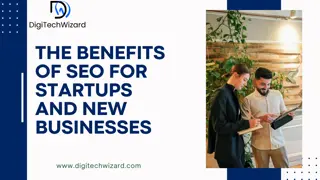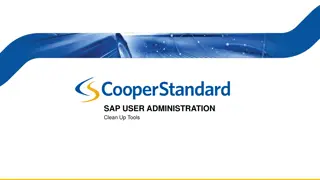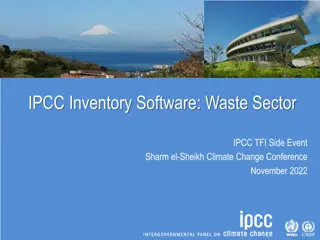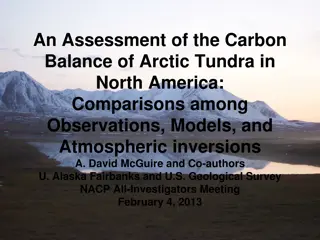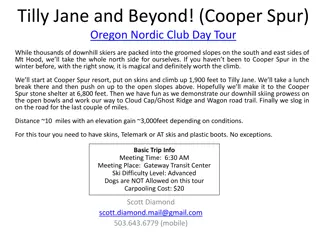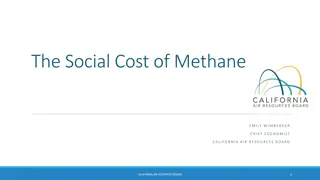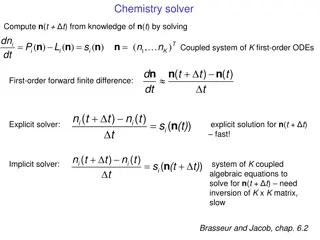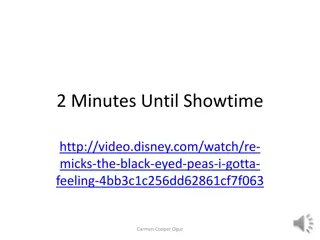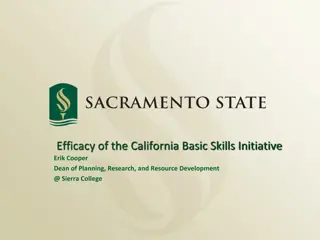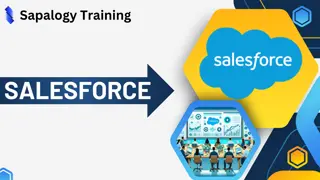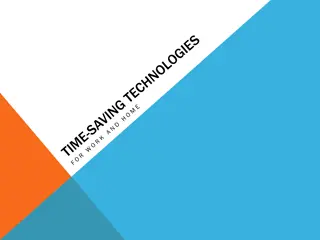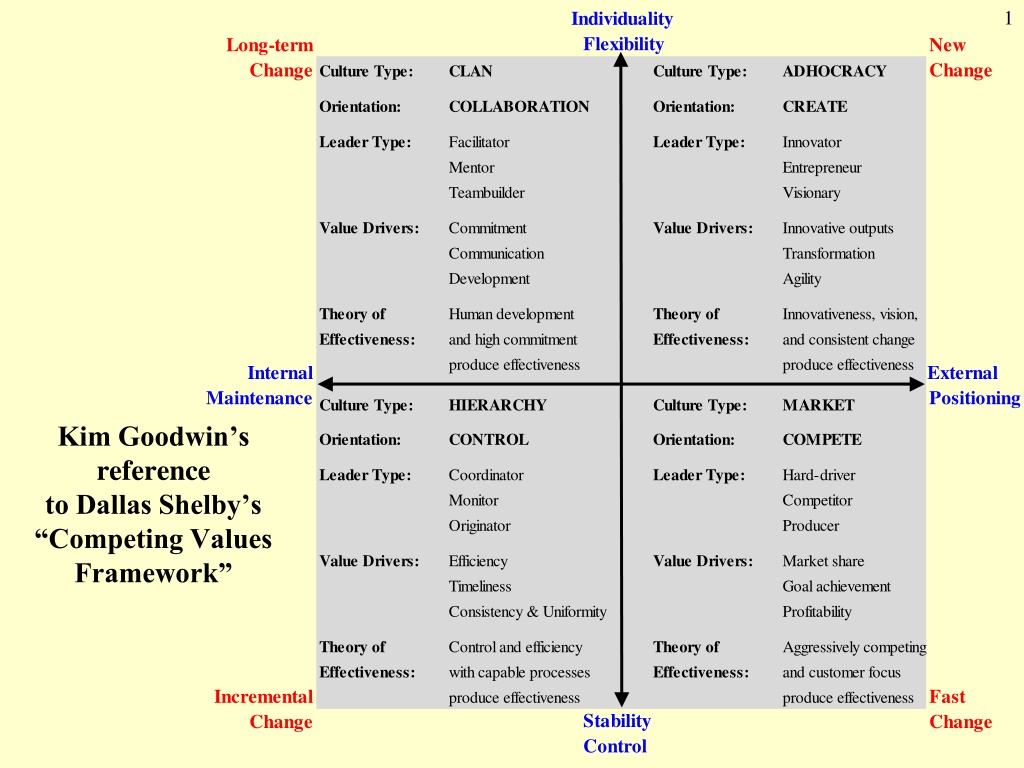
Creating Effective Organizational Cultures: Insights and Strategies
Explore the dynamics of different organizational cultures and leadership styles, with a focus on individuality, flexibility, and long-term change. Understand the key drivers of value and theories of effectiveness to optimize performance. Learn from industry examples and best practices to bridge the gap between research and design, ultimately creating solutions that satisfy and inspire users.
Download Presentation

Please find below an Image/Link to download the presentation.
The content on the website is provided AS IS for your information and personal use only. It may not be sold, licensed, or shared on other websites without obtaining consent from the author. Download presentation by click this link. If you encounter any issues during the download, it is possible that the publisher has removed the file from their server.
E N D
Presentation Transcript
1 Individuality Flexibility Long-term Change Culture Type: New Change CLAN Culture Type: ADHOCRACY Orientation: COLLABORATION Orientation: CREATE Leader Type: Leader Type: Facilitator Mentor Teambuilder Innovator Entrepreneur Visionary Value Drivers: Value Drivers: Commitment Communication Development Innovative outputs Transformation Agility Theory of Effectiveness: Theory of Effectiveness: Human development and high commitment produce effectiveness Innovativeness, vision, and consistent change produce effectiveness Internal External Positioning Maintenance Culture Type: HIERARCHY Culture Type: MARKET Kim Goodwin s reference to Dallas Shelby s Competing Values Framework Orientation: CONTROL Orientation: COMPETE Leader Type: Leader Type: Coordinator Monitor Originator Hard-driver Competitor Producer Value Drivers: Value Drivers: Efficiency Timeliness Consistency & Uniformity Market share Goal achievement Profitability Theory of Effectiveness: Theory of Effectiveness: Control and efficiency with capable processes produce effectiveness Aggressively competing and customer focus produce effectiveness Fast Incremental Change Stability Change Control
2 You can write them on paper, but they are only words The words have significance only if behaved. Behaviors have significance only if believed. Isadore Sharp CEO and Founder Four Seasons Hotels and Resorts
BBuckley - 3 CSc 238 Human Computer Interface Design Chapter 4 Setting the Vision: Scenarios and Design Requirements ABOUT FACE The Essentials of Interaction Design Cooper, Reimann, Cronin, and Noessel
4 The crux of the whole method How we use this understanding of people to create design solutions that satisfy and inspire users. Bridging the gap between research and design Personas are the main characters in this process A four step process: 1. Developing stories or scenarios as a means of imagining ideal user interactions 2. Using those scenarios to extract design requirements 3. Using these requirements in turn to define the product s fundamental interaction framework 4. Filling in that framework with ever-increasing amounts of detail
5 Scenarios: the narrative imagining a story about a person using our product leverages our creativity to a greater power than when we just imagine a better form factor * or configuration of screen elements experiences designed around a narrative (a story) tend to be more comprehensible and engaging for users Interaction design is first and foremost the design of behavior that occurs over time. * form factor examples: web app viewed on a high-res computer screen, a phone that must be small; light, low-res in bright sunlight and dark; a kiosk
6 Scenarios versus(Use Cases & User Stories) Use cases are a technique based on exhaustive descriptions of the system s functional requirements Focus is on low-level user action and the accompanying system response. how the system responds nothing about how the user s tasks are to be presented to the user or how they should be prioritized in the interface. All possible user interactions are treated as equally important.
7 User stories are short, simple descriptions of a feature told from the perspective of the person who desires the new capability, usually a user or customer of the system. They typically follow a simple template: As a <type of user>, I want <some goal> or I need so that <some reason>
8 Scenarios versus(Use Cases & User Stories) User stories are not stories but sentences. As a user, I would like to log I to my online banking account Followed by a brief description of the necessary interface These are phrased requirements not scenarios. Scenarios are more like Epics Epics do not describe task-level interactions, but rather broader and more far reaching cluster of interactions that are intended to meet user goals. the function and presentation of user interfaces and interactions
9 Scenario-based design John Carroll, Making Use Scenarios are paradoxically concrete but rough, tangible but flexible they implicitly encourage "what-if?" thinking among all parties. They permit the articulation of design possibilities without undermining innovation ... Scenarios compel attention to the use that will be made of the design product They can describe situations at many levels of detail, for many different purposes, helping to coordinate various aspects of the design project.
10 Carroll's use of Scenario-based design describes how users accomplish tasks note: the missing ingredient is the use of personas Personas are a tangible representation of the user that acts as a believable agent in the setting of a scenario Personas have goals not simply tasks Personas provide the means to determine What the product should do and how the product should look and behave. The design that starts with a story describing an ideal experience from the personas perspective how they think and behave, not focused on technology and business goals.
Scenarios capture the nonverbal dialogue between the user and a product, environment, or system over time as well as the structure and behavior of interactive functions 3 Types of Scenarios Context Scenarios High level description of how product serves the needs of users Key Path Scenarios Revised Context Scenarios Incorporates functional and data elements and the Design Framework Validation Scenarios Used by the team to test the design solution
12 Design Requirements The What of Interaction Design Information and capabilities the personas require to accomplish their goals Design requirements are NOT features! think of design requirements as being synonymous with needs. Define what the product will do before you design how the product wil do it. DESIGN PRINCIPLE
13 Design Requirements are not specifications not a list of capabilities generated by others rather than users! Marketing Req ts Docs (MRDs) and Product Req ts Docs (PRDs) confuse what the product should do with how
14 Example Mandating solutions before the design produces clunky and disjointed interactions and products Data Analytics Tool design Without understanding the what, the focus might be placed on just generating reports and User research, focused on identifying something tangible would uncover a multitude of reports. But the real requirements might be providing a way to recognize exceptional situations before opportunities are missed or problems arise.
15 Design req ts are strategic starting with req ts rather than solutions, allows interaction designers the ability to create powerful and compelling products. By clearly defining user needs, designers can work with technologists to find the best viable and feasible solutions without compromising the product s ability to help people achieve their goals.
16 Requirements Definition Process repeat until req ts are stable 1,2,3 Create Explore and Brainstorm Identify Persona Expectations Construct Identify Design Req'ts Problem and Vision Statements Context Scenarios The process Answers broad questions about what a product is and what it should do. The Framework Definition answers questions about how the product behaves and how it is structured to meet user needs.
17 Requirements Definition Five steps: 1. Create problem and vision statements 2. Explore / brainstorm 3. Identify persona expectations 4. Construct context scenarios 5. Identify design requirements Again cycling through steps 3 through 5 until the requirements are stable.
18 1. Create problem and vision statements Problem and vision statements provide a clear mandate for moving forward and are extremely helpful in building consensus among stakeholders before the design process moves forward Connecting business issues to usability issues is critical to drive stakeholders buy-in to design efforts andto frame the design effort in terms of both user and business goals. Sample template The new design of Product X will help users achieve G by allowing them to do X, Y and Z with greater [accuracy, efficiency, and so on], and without problems A, B and C that they currently experience. This will dramatically improve Company X's customer satisfaction ratings and lead to increased market share. User goals & needs should be derived from the primary & secondary personas and business goal from stakeholder interviews
19 2. Explore / brainstorm The primary purpose here is to eliminate as much preconception as possible. Doing so allows designers to be open-minded and flexible as they use their imagination to construct scenarios and to use their analytical skills to derive requirements from these scenarios. Focus is on how your personas would likely want to engage with the product. Brainstorming is used to get these ideas out of our heads so that we can record them and thereby "let them go" for the time being. A very, very collaborative process by necessity!
20 3. Identify persona expectations Important! The represented model of the interfaces (how the design behaves and presents itself) should match what the team understands about users mental modelas much as possible. The represented model should not reflect the implementation model That is, how the product will actually be constructed internally
21 Expectations For each primary and secondary persona, identify the following: Attitudes, experiences, aspirations, and other social, cultural, environmental, and cognitive factors that influence the personas expectations General expectations and desires the persona may have about the experience of using the product Behaviors the persona will expect or want from the product How that persona thinks about basic elements or units of data (For example, in an e-mail application, the basic elements of data might be messages and people.)
22 Some of the things to look for What do the interview subjects mention first? Which action words (verbs) do they use? What nouns? Which intermediate steps, tasks, or objects in a process don't they mention? (Hint: These might not be terribly important to how they think about things.)
23 4. Construct context scenarios Context scenarios tell the story of a particular user s persona, with various motivations, needs, and goals, using the future version of your product in the way that is most typical for that persona. This is where design begins Focus is on how the product being designed can best help personas achieve their goals. High level actions from the user s perspective
24 Context scenarios address questions In what setting(s) will the product be used? Will it be used for extended amounts of time? Is the persona frequently interrupted? Do several people use a single workstation or device? With what other products will it be used? What primary activities does the persona need to perform to meet her goals? What is the expected end result of using the product? How much complexity is permissible, based on persona skill and frequency of use? Don't yet worry about exactly how things will get accomplished. Initially you should treat the design as a bit of a magic blackbox.
25 The good sample context scenario Vivien s context scenario Primary persona for a personal digital device (PDA) (last paragraph) Good suggestion: Also notice how the activities in the scenario tie back to Vivien's goals and try to eliminate as many tasks as possible. DESIGN PRINCIPLE In the early stages of design, pretend the interface is magic Do not get side-tracked by thinking about the coding or the database
26 5. Identify design requirements After the initial draft of the context scenario is approved, analyze it to extract the personas' needs or design requirements. These design requirements consist of objects, actions, and contexts requirements that are identical to features or tasks Referring to Vivien s context scenario a requirement might read as Call (action) a person (object) directly for an appointment (context).
27 or separate the requirements Data Functional Business requirements can include stakeholder priorities, development timelines, budgetary and resource constraints, regulations and legal considerations, pricing structures, and business models. Brand and experience requirements reflect attributes of the experience you want users and customers to associate with your product, company, or organization. Technical requirements can include weight, size, form factor, display, power constraints, and software platform choices. Customer and partner requirements can include ease of installation Contextual Other
28 Next Chapter 5 A deeper dive into the details of your product s behaviors and beginning to consider how the product and its functions will be represented.





